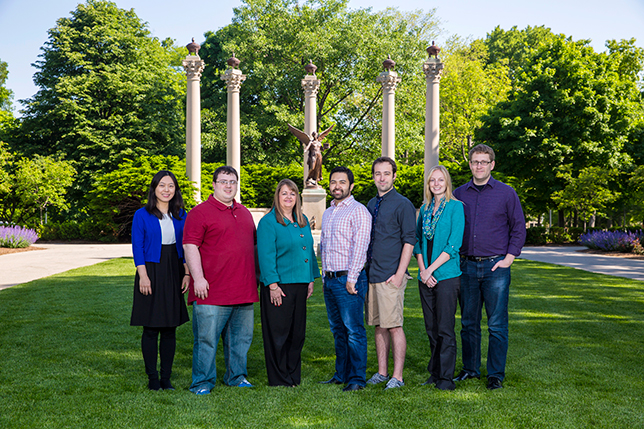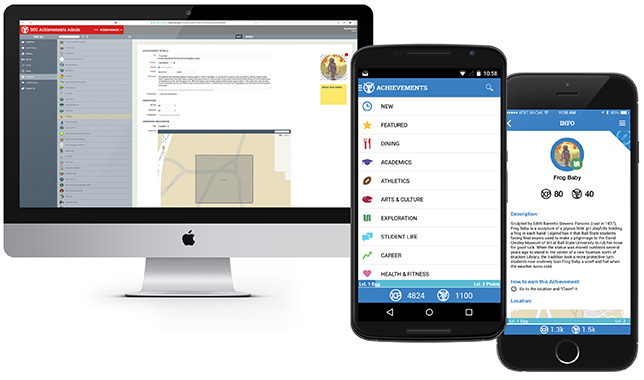Achieving Student Success Through Gamification
To improve retention and outcomes for Pell grant students, Ball State University developed a mobile app that uses gamification to incentivize positive activity outside the classroom.
Category: Student Systems and Services
Institution: Ball State University
Project: Ball State Achievements
Project lead: Kay Bales, vice president for student affairs and dean of students
Tech vendors/partners: Developed in-house

The Ball State Achievements team (left to right): Wen Qi, Scott Reinke, Kay Bales, Jonathan Blake Huer, Gunnar Hoffman, Brittanie Middleton and Ryan Bitzegaio (Ball State Photographic Services)
Student affairs professionals have long believed that non-academic aspects of campus life can have a significant impact on student success. Students who form social networks on campus, attend campus events or are involved in Greek life, for example, are more likely to complete their degrees.
So two years ago, as executives at Ball State University were thinking about how to improve student outcomes, they looked for ways to motivate students to become more active on campus. And they found an unlikely role model: Weight Watchers.
"Their users have individual goals related to losing weight. Our students have individual goals related to to getting to commencement and becoming gainfully employed," explained Kay Bales, vice president for student affairs and dean of students. "We looked at how people would use apps to find things that would motivate them to continue on in the weight loss process. From that, we started brainstorming about which of those principles we could use to create something that would assist our Pell grant students."
The result, Ball State Achievements, is a mobile app designed to improve retention and outcomes for Pell grant students by gamifying positive activity outside the classroom — providing a gentle nudge for students to take advantage of the opportunities already provided on campus.

The Ball State Achievements App incentivizes activities such as forming social networks on campus, engaging in Greek life or other student organizations, attending career center or other "work skills" events, and maintaining a healthy lifestyle.
"Our underlying premise is that if students are incentivized to do things that are helpful to them, then they will take advantage of it," Bales said. "It doesn't matter to us which particular activities students are engaged in; it is the fact that they are connecting with peers."
The Achievements app is like a frequent flier program for students. Students are awarded "Experience" points and "Bennies" as they complete various "Achievements." The Experience points accumulate and students can spend Bennies (named after Ball State's Beneficence statue) as a currency in exchange for bookstore items such as clothes, or at the campus Starbucks. The app encourages positive behaviors that occur outside the traditional classroom such as forming social networks on campus, engaging in Greek life or other student organizations, attending career center or other "work skills" events, and maintaining a healthy lifestyle.
With initial funding in 2013 from Next Generation Learning Challenges and Educause, Ball State tested a beta version of the app in the fall 2013 semester. Then with additional funding from NGLC, Ball State's Emerging Technologies program built native Android and iOS apps from scratch over a six-month period. In partnership with Student Affairs, it made a commitment to run the Achievements program for a full three years starting in fall 2014.
To design the app, Emerging Technologies took advantage of the skills of a group of student employees called the Digital Corps, a concept that itself won a Campus Technology Innovators award in 2008. "We were able to have all this highly skilled talent on campus we could apply to this exciting challenge for Student Affairs," said Jonathan Blake Huer, director of emerging technologies and media development. The system is composed of two parts: fully native Android and iOS apps distributed through their respective stores, and a cloud-based back end that lets various administrators across campus create and deploy achievements.
From the start, student adoption exceeded expectations. With a few e-mails, the app reached 25 percent market saturation in the first semester. Several weeks into the second semester, it had more than 700 active users (nearly 50 percent of the entire population of Pell grant students at the university).
"Coming from the technology side, I had zero idea what to expect in terms of uptake," Huer admitted. "So it was a good learning experience to see what motivated students and be able to provide that data to Dr. Bales and her staff — so we could dive into data we were getting from the app and focus groups and work on improvements."
Ball State plans to study whether the app has motivated students to participate more and whether that does indeed have an impact on student success. "The early results are promising," Huer said, adding that the app gives Student Affairs another way to reach students and let them know about activities taking place on campus.
Bales said it would take some time before they can assess the impact of the app. "We have made a three-year commitment to this project, knowing we wouldn't learn everything we need to know in the first year," she said. "So while the grant funding was for only one year, the institution is committed to continue building and testing the app and measuring the impact for three years."
But one huge potential benefit is gaining more revenue for the university through the State of Indiana's performance-based funding model for higher education. "If we invest in the app, but increase retention by a certain percentage, then through our performance funding formula, our program could end up paying for itself," Bales said. "That is our goal."
Bales and Huer stressed that one of the most exciting aspects of the project is the large volume of data being generated both for students who are successful and for those who are not, across a wide swath of campus activities. They see potential to tie into social media, academics and other sources of data to get a better picture of what causes students to succeed in the classroom.
And although Huer said the app's design is currently fully customized for Ball State, "architecturally we created it in a way that we could spin off other instances relatively easily. We are committed to doing research on this. We don't know if it works yet. It will take a while to find out," he said. "But should it prove to be very beneficial, we would be interested in commercializing it and rolling it out."
Return to Campus Technology Innovators Awards Home